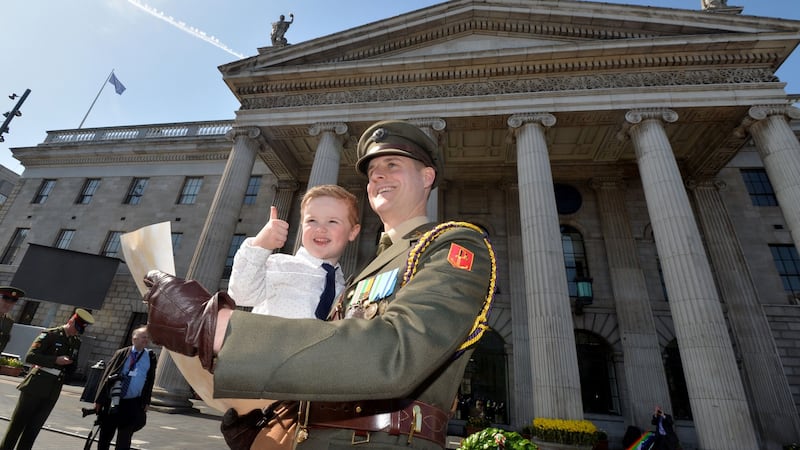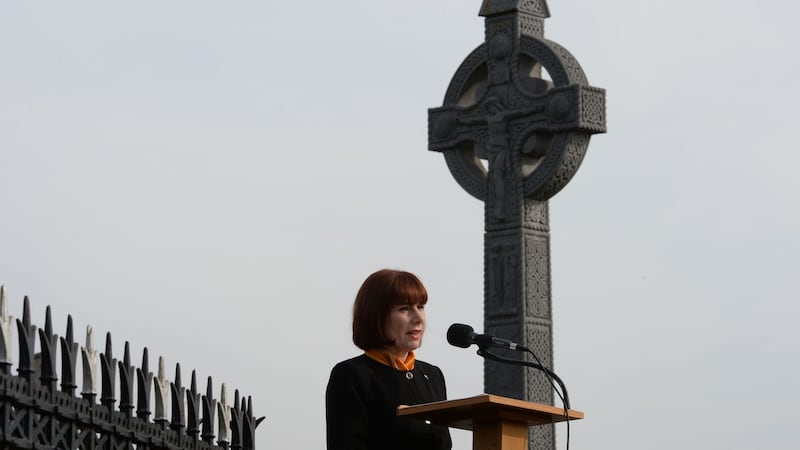President Michael D Higgins led a commemoration marking the 103rd anniversary of the 1916 Easter Rising at the GPO on Dublin's O'Connell Street on Sunday.
Also in attendance were Taoiseach Leo Varadkar, Minister of State for Defence Paul Kehoe, Lord Mayor of Dublin Cllr Nial Ring, and chief of staff of the Defence Forces Vice-Admiral Mark Mellett.
Mr Higgins and his wide Sabina were greeted on arrival by applause from members of the public who had gathered across from the GPO, the rebels’ headquarters during the Rising, to watch proceedings.
The President inspected the guard of honour, made up of members of the 95th Cadet Class, whose 83 members began training at the Curragh, Co Kildare, last September.
The Tricolour at the top of the GPO was lowered to half-mast and a prayer service was led by the head chaplain to the Defence Forces, Fr Séamus Madigan.
A lone piper, Pte Aidan Gillespie, then played a lament. This was followed by a reading of the 1916 Proclamation of the Irish Republic in front of the GPO by Capt Paul Conlon, a staff officer in human resources at Defence Forces headquarters.

On Easter Monday 1916, rebel leader Patrick Pearse stood outside the GPO and read out the Proclamation to herald the start of the insurrection against British rule.
After the reading, Mr Varadkar invited Mr Higgins to lay a wreath opposite the GPO. The laying of the wreath was followed by a minute’s silence. The Tricolour at the top of the GPO was then raised to full mast and Reveille was played, followed by the national anthem, Amhrán na bhFiann.
As the anthem's concluding notes were sounded, an Air Corps flypast, involving three aircraft, moved through the clear blue sky above.
Glasnevin ceremony
Earlier, Minister for Heritage Josepha Madigan led a remembrance ceremony at Glasnevin Cemetery in Dublin for those who died in the rebellion. A Tricolour was raised by members of the Defence Forces and the national anthem was played by a lone piper.
Ms Madigan laid a wreath at Sigerson Monument and others were placed at the graves of Edward Hollywood, the man who delivered the first Tricolour flag to Ireland from France, and Peadar Kearney, who wrote the national anthem.
Ms Madigan was joined by counsellor Catherine Page from the British embassy, Brig Gen Howard Berney of the Defence Forces, and French ambassador Stéphane Crouzat. A relative of Kearney's, Ciara Considine, sang the anthem.

“Over the past 187 years, people have gathered here in Glasnevin Cemetery to mark the passing of 1½ million individuals,” Ms Madigan said, adding that the cemetery had been a place for solemn and significant occasions as well as commemorations, and was the burial place of key persons in Irish history.
“The sacrifice of those who died for Irish freedom is acknowledged and perhaps better understood today, and the legacy of 1916 has passed on to new generations and informed and guided our path to independence and the first 100 years of the latest chapter in Ireland’s history.”
A granite memorial incorporating the names of all those who died in the Rising, including rebellion leaders and British soldiers, was unveiled in Glasnevin as part of the centenary commemorations in 2016.
Almost 500 people were killed in the uprising, the majority of them – 268 – civilians caught up in the violence. A total of 119 British soldiers died.
John Green, chairman of Glasnevin Trust, said it was "hugely important" that the young men and women who died in Easter Week 1916 are not forgotten.
“It’s remembrance days like these at Glasnevin Cemetery, where so many men and women of the Easter Rising of 1916 are buried, that allow us the chance to reflect on our history as a nation,” he said. (Additional reporting – PA)











